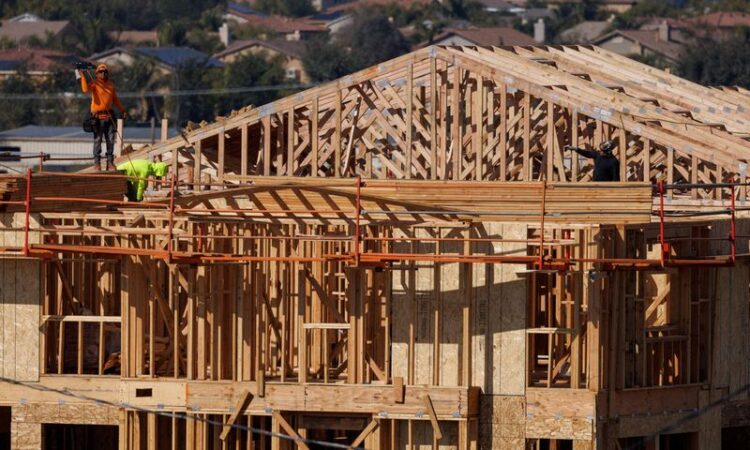
By Lucia Mutikani
WASHINGTON (Reuters) – Sales of new U.S. single-family homes rebounded in March from February’s downwardly revised level, drawing support from a persistent shortage of previously owned houses on the market, but momentum could be curbed by a resurgence in mortgage rates.
The report from the Commerce Department on Tuesday also showed the median house price jumped to a seven month-high from February, likely as fewer builders offered price cuts and sales shifted to higher priced homes. Rising prices and mortgage rates could make housing even more unaffordable, especially for first-time buyers.
“New home sales have remained remarkably strong recently,” said Oliver Allen, senior U.S. economist at Pantheon Macroeconomics. “That said, the renewed rise in mortgage rates and dip in mortgage applications over the past couple of months means that new home sales will probably tread water at best in the near-term, while existing home sales will fall.”
New home sales jumped 8.8% to a seasonally adjusted annual rate of 693,000 units last month, the highest level since September, the Commerce Department’s Census Bureau said. The sales pace for February was revised down to 637,000 units from the previously reported 662,000 units.
Economists polled by Reuters had forecast new home sales, which account for about 14% of U.S. home sales, would advance by a rate of 670,000 units.
New home sales are counted at the signing of a contract, making them a leading indicator of the housing market. They, however, can be volatile on a month-to-month basis. Sales increased 8.3% on a year-on-year basis in March.
Though the new housing market remains underpinned by the dearth of previously owned homes for sale, rising mortgage rates are taking a toll on affordability.
Data last week showed single-family housing starts and building permits declined in March. Sentiment among single-family homebuilders was unchanged in April, with the National Association of Home Builders noting that “buyers are hesitating until they can better gauge where interest rates are headed.”
The average rate on the popular 30-year fixed-rate mortgage has risen back above 7%, data from mortgage finance agency Freddie Mac showed, as strong reports on the labor market and inflation suggested the Federal Reserve could delay an anticipated interest rate cut this year. A few economists doubt the U.S. central bank will lower borrowing costs in 2024.
BROAD INCREASE
New home sales rose in all four regions last month, with the Northeast posting a 27.8% surge. Sales in the Midwest gained 5.3% and increased 7.7% in the densely populated South. They vaulted 8.6% in the West.
Despite the weakness in permits last month, economists believed residential investment picked up in the first quarter after slowing considerably in the October-December period.
The government is scheduled to publish its snapshot of gross domestic product for the first quarter on Thursday. Growth estimates for the period are as high as a 3.1% annualized rate. The economy grew at a 3.4% pace in the fourth quarter.
Stocks on Wall Street were trading higher. The dollar fell against a basket of currencies. U.S. Treasury prices rose.
The median new house price increased 6% to $430,700 from February. That was the highest level since last August. Prices, however, slipped 1.9% from a year ago. Most of the new homes sold last month were in the $300,000-$399,999 price range, followed by the $500,000-$749,000 price bracket.
Builders are constructing smaller and cheaper houses, but fewer of them are cutting prices. The NAHB survey last week showed the share of builders cutting prices fell to 22% in April from 24% in March and 36% in December. Fewer builders were also offering incentives to boost sales.
Overall house prices continue to rise because of the supply squeeze in the home resale market. Data from mortgage finance agency Fannie Mae last week showed house prices increased 7.4% on a year-on-year basis in the first quarter compared to a 6.6% rise in the fourth quarter. Fannie Mae upgraded its estimate for home price growth this year to 4.8% from 3.2% previously.
There were 477,000 new homes on the market at the end of March, up from 465,000 units in February. At March’s sales pace it would take 8.3 months to clear the supply of houses on the market, down from 8.8 months in February.
Houses under construction accounted for 59.1% of inventory. Homes yet to be built made up 22.2% of supply, while completed houses accounted for 18.7%.
(Reporting by Lucia Mutikani; Editing by Chizu Nomiyama and Paul Simao)






